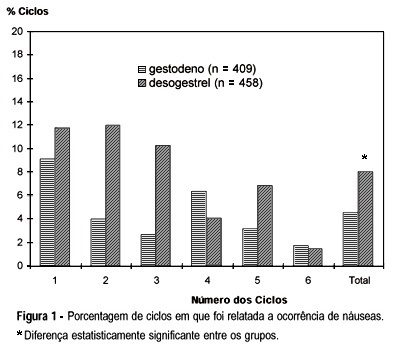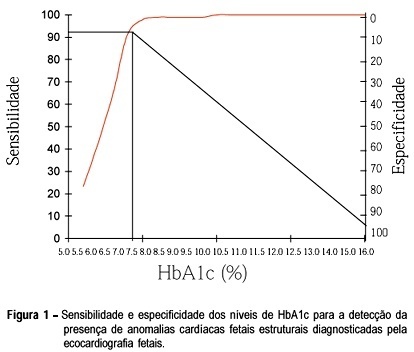Summary
Revista Brasileira de Ginecologia e Obstetrícia. 1998;20(5):273-280
DOI 10.1590/S0100-72031998000500007
An open-label comparative study was conducted in nine centers in Brazil to evaluate the tolerability and cycle control of two low-dose oral contraceptives containing 20 mg ethynylestradiol/75 mg gestodene and 20 mg ethynylestradiol/150 mg desogestrel, during six treatment cycles. A total of 167 healthy sexually active women were enrolled (77 in the gestodene group and 90 in the desogestrel group) and 138 completed the six-cycle treatment period. A lipid and hemostatic profile was performed for a subgroup of first users. A total of 867 cycles were evaluated. Irregular bleeding did not occur in 95.4% of the cycles evaluated with gestodene and in 91.9% with desogestrel. Tolerability was good with both preparations but there was significantly more nausea in the desogestrel group. Cycle control was good with both preparations with a significantly lower incidence of irregular bleeding with gestodene when all cycles were considered. There were no clinically significant changes in the hemostatic profile. Lipid profile showed a trend to be more favorable after six cycles of treatment with both preparations. Women in the gestodene group did not present changes in the mean weight; in the desogestrel group there was a significant mean weight increase of 1 kg after six cycles of treatment. Compliance with treatment was good with both preparations. Results of this study demonstrated that low-dose preparations containing gestodene or desogestrel combined with 20 mg of ethynylestradiol are well-tolerated oral contraceptives that provide good cycle control.

Summary
Revista Brasileira de Ginecologia e Obstetrícia. 1998;20(5):267-271
DOI 10.1590/S0100-72031998000500006
Objective:To analyze the levels of endogenous sexual steroids and gonadotrophin in women with and without endometrial cancer. Methodology:We developed a clinical comparative study on 20 postmenopausal women with endometrial cancer and 20 postmenopausal women without endometrial cancer. The age, the postmenopausal time and the index of body mass were used as matching variables. The plasma levels of the endogenous sexual steroids were measured using radioimmunoassay and immunoenzymatic methods. For the statistic analysis we used the Student's t test. Results: The levels of androstenedione (A), total testosterone (t) and free testosterone (TL) were higher in the women with endometrial cancer, and those of the luteinic hormone (LH) were significantly lower values in these women. We also observed that the ratio (E1/A) showed significantly lower in the group of women with cancer, while the ratio (E2/E1) did not present any differences between groups. Conclusions: We emphasize the potentiality of sexual steroids and gonadotrophins in the genesis of endometrial adenocarcinoma in postmenopausal women.
Summary
Revista Brasileira de Ginecologia e Obstetrícia. 1998;20(5):261-264
DOI 10.1590/S0100-72031998000500005
The disadvantages of the second twin in respect of his birth conditions are of great concern. In this study we have reviewed 90 twin births occurred at the Maternidade da Encruzilhada (CISAM) in Recife, from January/92 to December/93, in order to compare perinatal variables between the first and second twin. Fetal presentation, way of delivery, birth weight, Apgar of the 1st and 5th minutes, occurrence of perinatal complications such as hyaline membrane syndrome, transitory tachypnea, and neonatal infection and, finally, the prognosis of each of the twins were evaluated. There was no statistical difference between the incidence of non-vertex presentation, cesarean section, low birth weight, Apgar < 7 in the 1st and 5th minutes and neonatal complication cited above. There was also no difference in perinatal mortality between the first and the second twin. Our results suggest a similar birth condition for both twins of a same pregnancy, therefore, the same perinatal care must be provided for each one.
Summary
Revista Brasileira de Ginecologia e Obstetrícia. 1998;20(5):253-260
DOI 10.1590/S0100-72031998000500004
Objectives: To determine sensitivity, specificity, positive and negative predictive values of the shake test (Clements) for evaluation of fetal lung maturation in preeclamptic patients. Methods: A prospective study for validation of a diagnostic method was conducted enrolling 163 preeclamptic patients (gestational age between 28-34 weeks) admitted at CAM-IMIP with indication for fetal maturity testing. Preeclampsia diagnosis and classification followed criteria of the National High Blood Pressure Working Group, 1990. Clements' test was performed in three tubes and positive, negative or intermediate results were considered for analysis (related to presence or absence of fetal lung maturity). Accuracy parameters were calculated considering actual incidence of hyaline membrane disease (positive maturity = absent disease) after birth. Hyaline membrane disease was defined by criteria of CLAP, 1978. Statistical analysis was performed using c² test (Epi-Info 6.04b) with a 5% significance level. Results: Intermediate results were considered alternately as positive or negative for analysis. When considered positive, sensitivity was 87.9% and specificity 74.5% with positive and negative predictive values of 8.9.4% and 71.4% respectively - efficiency was 84%. When intermediate results were evaluated as negative, sensitivity decreased to 62% and specificity raised to 89.4% and positive and negative predictive values were 93.5% and 51.2% respectively (efficiency = 70%). False-positive results were rare and usually related to neonatal hypoxia: only 5 (6.5%) of 77 neonates with previous positive Clements had hyaline membrane disease. Nevertheless, false negatives were frequent: almost 40% for negative/intermediate results. Conclusions: Despite its limitations, Clements' test remains a good method for investigation of fetal lung maturation in preeclamptic patients since false positive results are unusual. However sensitivity is low and results have be cautiously analyzed because of elevated rate of false negative results. A good policy is to complement fetal maturity investigation with other tests if a negative result is determined, specially in severe cases when confirmed maturity represents indication for interruption of pregnancy.
Summary
Revista Brasileira de Ginecologia e Obstetrícia. 1998;20(5):245-249
DOI 10.1590/S0100-72031998000500003
The purpose of the present study was to evaluate the effects of acetylsalicylic acid (ASA) on the pregnancy of female albino rats. We used 60 pregnant female rats which were divided into six groups of ten cache. All the animals received daily by gavage, from the 5th (day zero) until the 20th day of pregnancy, 1 ml of the following: Group I - only distilled water (control); Group II - 0.2% aqueous solution of carboxymethylcellulose (vehicle); Groups III, IV, V and VI - 1, 10, 100 and 400 mg/kg body weight respectively, of ASA diluted in 0.2% carboxymethylcellulose solution. The animals were weighed on days 0, 7, 14 and 20 of pregnancy. Our results showed that the animals treated with 100 mg of ASA presented a reduction in the number of live newborns. The animals treated with 400 mg/kg/day presented not only a reduction in the number of live newborns but also decrease in maternal, newborn and placental weight.

Summary
Revista Brasileira de Ginecologia e Obstetrícia. 1998;20(4):187-192
DOI 10.1590/S0100-72031998000400003
The present study describes 13 cases of appendicitis in the gravidic-puerperal cycle, at the Maternidade Escola Januário Cicco, from Jan/89 to Dec/96. The cases were assisted by a team of obstetricians and surgeons. Eleven patients were pregnant (4 in the 1st trimester, 6 in the 2nd and 1 in the 3rd) and 2 were in the puerperal period. The incidence was 1/3.422; the age ranged from 18 to 30 years and the majority was nulliparous. The most frequent symptom was abdominal pain (intense or moderate). The appendix was perforated in 6 cases, 2 of them with abdominal wall abscess and 1 patient had an abortion. Pregnancy presented no complications in 9 cases, and delivery occurred at term. The authors observed that appendix perforations occurred more frequently in cases whose symptoms had begun earlier. The authors found that the earlier the diagnosis, the better the prognosis.
Summary
Revista Brasileira de Ginecologia e Obstetrícia. 1998;20(4):181-185
DOI 10.1590/S0100-72031998000400002
With the purpose of identifying the social, demographic, pregnancy-related and medical care factors associated with maternal death, this study evaluated all deaths of women aged 10 to 49 years occurring in Recife, Pernambuco, Brazil, during 1992 and 1993. The data were obtained reviewing 1,013 death certificates, with 42 cases of identified maternal deaths. The data of these deaths were complemented with information from medical records, autopsies and also interviews with physicians from the hospitals where the death took place, and with the dead women's relatives. Almost two thirds (62%) of maternal deaths occurred among women aged 20 to 29 years and more than half of them were single. There was a higher number of deaths among caesarean deliveries than among vaginal ones. The majority of deaths occurred within the first three days of hospitalization and approximately 90% of hospital charges were sponsored by the National Health System (SUS).
Summary
Revista Brasileira de Ginecologia e Obstetrícia. 1998;20(5):237-243
DOI 10.1590/S0100-72031998000500002
We analyze prospectively the existence of a relationship between the mother's glycemic control, in the first half of pregnancy, and the occurrence of abnormal fetal cardiac abnormalities, in pregnant women with diabetes mellitus. In 127 pregnant women, the level of glycosylated hemoglobin was determined on the first visit during prenatal care. Nine patients had type I diabetes, 77 type II and 41 gestational diabetes mellitus (GDM). All mothers were submitted to detailed fetal echocardiography, during the 28th ± 4.127 week of gestation. In 31 (24.4%) of the 127 fetuses cardiac anomalies were detected. In 10 (7.87%) an isolated cardiac anomaly was identified. Mean HbA1c in the group of pregnant women without cardiac anomalies (5.64%) was statistically different from the group with anomalies (10.14%) (p<0.0001). The receiver-operator characteristic, representing the balance between sensitivity (92.83%) and specificity (98.92%) in the diagnosis of structural cardiac abnormalities, showed a cut-off point at the 7.5% HbA1c level. In nine of ten fetuses with structural cardiac anomalies, the maternal level of HbA1c was higher than 7.5%. The difference between means of the groups with and without myocardial hypertrophy diagnosed as isolated anomaly (MCHP) was not statistically significant, when considering both type II diabetes and GDM subgroups. In conclusion, levels of HbA1c higher than 7.5% were associated with most cases of echocardiographycally diagnosed structural cardiac anomalies. On the other hand, this test was not useful to discriminate conceptus with MCHP.
